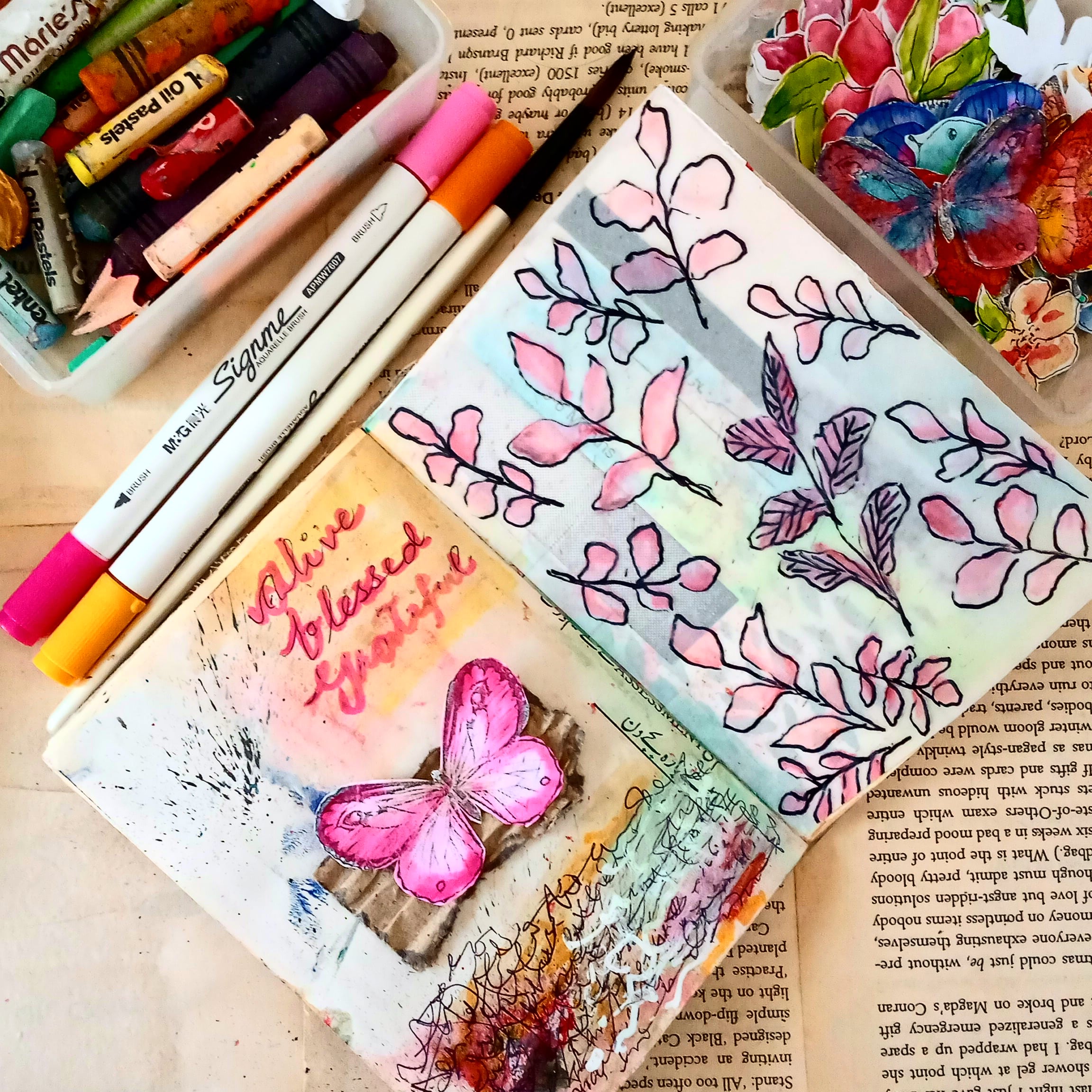If anxiety has been weighing you down, know that you are not alone.
It is a feeling of worry, fear, or nervousness that can be overwhelming. It’s a common struggle that can affect anyone. But it can be managed and soothed through creative expression, self-reflection, and mindfulness practices like art journaling.
Discover how art journaling for anxiety relief fosters healing and emotional well-being on your journey to mental peace.
The connection between Art and Anxiety
Art-making is a recognized therapeutic activity. It allows you to express and process your emotion in Non-verbal manners.
Art journaling offers you a safe space for self-expression, experiment and reflection. By combining art-making with a journal you can tap into your thoughts, feelings and bodily sensations gaining insight into your anxiety pattern.
Art journaling is like a conversation with your inner self. It’s a mix of art, writing, and emotions that helps you process your thoughts and feelings.
Imagine having a space where you can:
- Express yourself freely
- Experiment with art and colors
- Document your journey and growth
- Practice mindfulness and self-care
All you need is a journal and your favorite art supplies!
Healing Strokes
\”Healing Strokes\” are therapeutic and meditative marks made on paper through art journaling.
These strokes can be:
- Gentle, expressive brush strokes with paint or ink.
- Soothing, repetitive lines with pens, pencils and markers
- Texture and patterns created with collage and mixed media.
These healing strokes can:
- Calm the mind and emotions.
- Release tension and stress
- Foster self-expression and reflection.
- Promote Mindfulness and Presence
- Create a sense of control and empowerment
Ultimately, \”Healing strokes\” in art journaling transform the creative process into a therapeutic journey, where every mark, line and Color becomes a step forward towards healing, growth and self-discovery.
Here are some steps, tips and tricks for creating \”healing strokes\” in art journals.
Steps:
1. Gather Your Tools: Journal, art supplies, and a cozy space.\”
2. Set Your Intention: Commit to regular practice, even if just 10 minutes.
3. Explore and Express: Play with colors, textures, and themes.
4. Reflect and Write: Record insights and emotions.
5. Practice Self-Compassion: Remember, this is your journey.
Tips:
1. Experiment with different tools and techniques.
2. Use gentle, flowing motions to create soothing strokes.
3. Incorporate natural materials like leaves or flowers.
4. Play with colors and textures to evoke emotions.
5. Make it a habit: Regular art journaling practice fosters growth.
Tricks:
1. Use your non-dominant hand for unexpected marks.
2. Try blind contour drawing for intuitive expression.
3. Incorporate words or quotes for added meaning.
4. Experiment with different paper types and textures.
5. Don\’t worry about perfection – embrace imperfection
Remember, \”Healing Strokes\” in art journaling is a personal journey. Feel free to adapt and evolve these steps, tips, and tricks to suit your unique needs and creative expression.
Below are some my art journal pages for inspirations.


Overcoming Obstacles in Art Journaling for Anxiety Relief.
Here are some potential challenges and tips on how to overcome them when practicing art journaling for anxiety relief:
- Self-criticism: Feeling like your art isn\’t good enough.
Solution: Remind yourself that art journaling is about expression, not perfection. Focus on the process, not the outcome.
- Perfectionism: Spending too much time on a single page or feeling like it\’s not complete.
Solution: Set a timer and work within a specific timeframe. Practice embracing imperfection and moving on.
- Emotional overwhelm: Feeling overwhelmed by emotions while journaling.
Solution: Take breaks, practice grounding techniques, and focus on simple, calming art-making.
- Comparison: Comparing your art to others.
Solution: Follow diverse artists for inspiration, but avoid comparison. Focus on your unique journey and growth.
- Consistency: Struggling to maintain a regular journaling practice.
Solution: Start small, schedule journaling time, and be flexible. Even a minutes a day can be beneficial.
- Fear of vulnerability: Feeling uncomfortable expressing emotions or thoughts.
Solution: Begin with small, comfortable steps. Remember, your journal is for your eyes only.
- Physical discomfort: Experiencing physical discomfort while journaling (e.g., hand cramps).
Solution: Take breaks, stretch, and experiment with different tools and techniques to find what works best for you.
- Lack of inspiration: Feeling stuck or unsure what to create.
Solution: Experiment with prompts, explore different mediums, and seek inspiration from nature, books, or online resources.
By acknowledging these potential challenges and implementing strategies to overcome them, you can cultivate a nourishing art journaling practice that supports your anxiety relief journey.
